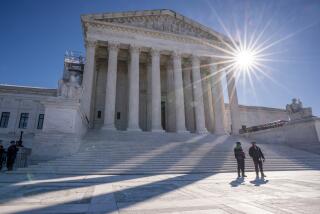Cameras on the Court
- Share via
The U.S. Senate has gone on television, and the Republic survives. House sessions have been televised for a number of years, as have key congressional hearings. There is only limited access to the White House, but Presidents at least go before television cameras periodically to defend their policies in open press conferences.
Now there is hope that television may at last strip away some of the mystery that surrounds the third branch of the federal establishment, the U.S. Supreme Court. During his (televised) hearings on confirmation as chief justice of the United States, Associate Justice William H. Rehnquist said that he would be willing to consider opening the court to the broadcasting of sessions in which cases are argued before the courts. First, Rehnquist said, he would want to be certain that television would not disrupt or distort order in the court.
There is no reason that such would be the case. Even trial courts now are televised routinely. In the Supreme Court there are no witnesses to be intimidated by the probing eye of the camera, only the advocates who are there to present the most critical issues of the nation and to have their arguments tested by the questions of the justices. The sanctity of the court’s internal deliberations and decision-making would remain as private and as protected as ever, and properly so.
Judge Antonin Scalia, the other recent Supreme Court nominee, said he would be inclined to agree with Rehnquist. Retiring Chief Justice Warren E. Burger opposes television coverage of the court.
The Supreme Court is the caldron in which the most basic fundamentals and the broadest theories of American government are argued and debated, the checks and balances are weighed in the most specific of terms, the rights of the minority are painstakingly protected against the force of the majority, the passions of politics are distilled into justice. In the court’s hallowed chamber the trusted traditions of American law run pell-mell into the realities of a changing world.
Extending the gallery of the court to all America via television could provide the citizens with a fascinating and valuable civics lesson. Once the court’s reorganization is complete, with the seating of Rehnquist and Scalia, one of its first decisions should be to open the court to cameras.
More to Read
Get the L.A. Times Politics newsletter
Deeply reported insights into legislation, politics and policy from Sacramento, Washington and beyond. In your inbox twice per week.
You may occasionally receive promotional content from the Los Angeles Times.










